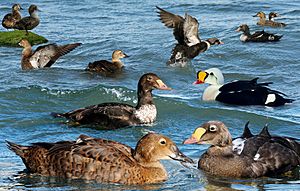King Eider facts for kids
Quick facts for kids King Eider |
|
|---|---|
 |
|
| Male at Central Park Zoo, New York, USA | |
| Conservation status | |
| Scientific classification | |
| Kingdom: | |
| Phylum: | |
| Class: | |
| Order: | |
| Family: | |
| Subfamily: | |
| Genus: | |
| Species: |
S. spectabilis
|
| Binomial name | |
| Somateria spectabilis (Linnaeus, 1758)
|
|
The King Eider (Somateria spectabilis) is a large sea duck that lives in the Arctic. These amazing birds spend most of their lives in cold ocean waters. They are known for their beautiful colours, especially the males!
King Eiders breed along the Arctic coasts of northern Europe, North America, and Asia. When winter comes, they fly to warmer (but still cold!) ocean areas. You can find them in places like the Bering Sea, Greenland, eastern Canada, and northern Norway. Sometimes, they are also seen off the northeastern United States, Scotland, and Kamchatka.
Contents
What do King Eiders look like?
The King Eider is a bit smaller than the Common Eider. It's easy to spot the male King Eider because of his unique look.
- The male has a black body and a bright white chest.
- His head is very colourful, with shades of blue, green, yellow, and orange.
- The male's call sounds like a deep cooing sound.
The female King Eider looks quite different.
- She is mostly a brown bird.
- You can tell her apart from other ducks by her size and shape.
- Her head is shorter than a Common Eider's, and the feathers on her bill are rounded, not pointy.
Young male King Eiders (called immature drakes) are usually dark with a white chest and a yellow patch on their bill.

What do King Eiders eat?
King Eiders are great divers! They dive deep into the water to find their food. They mostly eat small creatures that live on the seafloor, like:
- Crustaceans (like crabs and shrimp)
- Polychaete worms
- Molluscs (like clams and snails)
Their favourite food is mussels. In winter, many King Eiders gather together in huge groups on the coast. Some of these groups can have more than 100,000 birds!
Where do King Eiders breed?
King Eiders travel to the Arctic tundra to breed in June and July. This is where they lay their eggs and raise their young.
- They make a simple nest, called a scrape, on the ground.
- They line the nest with grass and soft feathers (called down) from their own bodies.
- Females usually lay four to seven eggs.
- Important breeding areas include the Arctic coastal tundra along the north coast of Alaska.
King Eiders and people
For people living in the Arctic, the King Eider is an important source of fresh meat, especially in the spring.
- King Eiders start their journey past the Yukon–Kuskokwim Delta in late April.
- Many are hunted during this time.
- In May, hundreds of thousands of King Eiders fly past Point Barrow in northern Alaska. They are on their way to their breeding grounds in Alaska and Canada.
Images for kids
-
Female at Alaska Sea Life Center, Seward, Alaska
See also
 In Spanish: Eider real para niños
In Spanish: Eider real para niños







